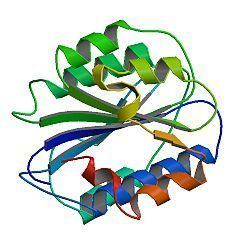Entrez 7450 | Ensembl ENSG00000110799 | |
 | ||
Aliases VWF, F8VWD, von Willebrand factor External IDs OMIM: 613160 MGI: 98941 HomoloGene: 466 GeneCards: VWF | ||
Platelets and von willebrand factor animation
Von Willebrand factor (vWF) (/ˌfʌnˈvɪlᵻbrɑːnt/) is a blood glycoprotein involved in hemostasis. It is deficient or defective in von Willebrand disease and is involved in a large number of other diseases, including thrombotic thrombocytopenic purpura, Heyde's syndrome, and possibly hemolytic-uremic syndrome. Increased plasma levels in a large number of cardiovascular, neoplastic, and connective tissue diseases are presumed to arise from adverse changes to the endothelium, and may contribute to an increased risk of thrombosis.
Contents
- Platelets and von willebrand factor animation
- Von willebrand factor vwf animation
- Synthesis
- Structure
- Function
- Catabolism
- Role in disease
- History
- Interactions
- References
Von willebrand factor vwf animation
Synthesis
vWF is a large multimeric glycoprotein present in blood plasma and produced constitutively as ultra-large vWF in endothelium (in the Weibel-Palade bodies), megakaryocytes (α-granules of platelets), and subendothelial connective tissue.
Structure
The basic vWF monomer is a 2050-amino acid protein. Every monomer contains a number of specific domains with a specific function; elements of note are:
Monomers are subsequently N-glycosylated, arranged into dimers in the endoplasmic reticulum and into multimers in the Golgi apparatus by crosslinking of cysteine residues via disulfide bonds. With respect to the glycosylation, vWF is one of only a few proteins that carry ABO blood group system antigens.
Multimers of vWF can be extremely large, >20,000 kDa, and consist of over 80 subunits of 250 kDa each. Only the large multimers are functional. Some cleavage products that result from vWF production are also secreted but probably serve no function.
Function
Von Willebrand factor's primary function is binding to other proteins, in particular factor VIII, and it is important in platelet adhesion to wound sites. It is not an enzyme and, thus, has no catalytic activity.
vWF binds to a number of cells and molecules. The most important ones are:
vWF plays a major role in blood coagulation. Therefore, vWF deficiency or dysfunction (von Willebrand disease) leads to a bleeding tendency, which is most apparent in tissues having high blood flow shear in narrow vessels. From studies it appears that vWF uncoils under these circumstances, decelerating passing platelets. Recent research also suggests that von Willebrand factor is involved in the formation of blood vessels themselves, which would explain why some people with von Willebrand disease develop vascular malformations (predominantly in the digestive tract) that can bleed excessively.
Catabolism
The biological breakdown (catabolism) of vWF is largely mediated by the enzyme ADAMTS13 (acronym of "a disintegrin-like and metalloprotease with thrombospondin type 1 motif no. 13"). It is a metalloproteinase that cleaves vWF between tyrosine at position 842 and methionine at position 843 (or 1605–1606 of the gene) in the A2 domain. This breaks down the multimers into smaller units, which are degraded by other peptidases.
Role in disease
Hereditary or acquired defects of vWF lead to von Willebrand disease (vWD), a bleeding diathesis of the skin and mucous membranes, causing nosebleeds, menorrhagia, and gastrointestinal bleeding. The point at which the mutation occurs determines the severity of the bleeding diathesis. There are three types (I, II and III), and type II is further divided in several subtypes. Treatment depends on the nature of the abnormality and the severity of the symptoms. Most cases of vWD are hereditary, but abnormalities of vWF may be acquired; aortic valve stenosis, for instance, has been linked to vWD type IIA, causing gastrointestinal bleeding - an association known as Heyde's syndrome.
In thrombotic thrombocytopenic purpura (TTP) and hemolytic uremic syndrome (HUS), ADAMTS13 either is deficient or has been inhibited by antibodies directed at the enzyme. This leads to decreased breakdown of the ultra-large multimers of vWF and microangiopathic hemolytic anemia with deposition of fibrin and platelets in small vessels, and capillary necrosis. In TTP, the organ most obviously affected is the brain; in HUS, the kidney.
Higher levels of vWF are more common among people that have had ischemic stroke (from blood-clotting) for the first time. Occurrence is not affected by ADAMTS13, and the only significant genetic factor is the person's blood group.High plasma vWF levels were found to be an independent predictor of major bleeding in anticoagulated atrial fibrillation patients.
History
vWF is named after Dr. Erik von Willebrand (1870–1949), a Finnish doctor who in 1924 first described a hereditary bleeding disorder in families from the Åland islands, who had a tendency for cutaneous and mucosal bleeding, including menorrhagia. Although von Willebrand could not identify the definite cause, he distinguished von Willebrand disease (vWD) from hemophilia and other forms of bleeding diathesis.
In the 1950s, vWD was shown to be caused by a plasma factor deficiency (instead of being caused by platelet disorders), and, in the 1970s, the vWF protein was purified.
Interactions
Von Willebrand factor has been shown to interact with Collagen, type I, alpha 1.
Recently, It has been reported that the cooperation and interactions within the Von Willebrand factors enhances the adsorption probability in the primary hameostasis. Such cooperation is proven by calculating the adsorption probability of flowing vWF once it crosses another adsorbed one. Such cooperation is held within a wide range of shear rates.
